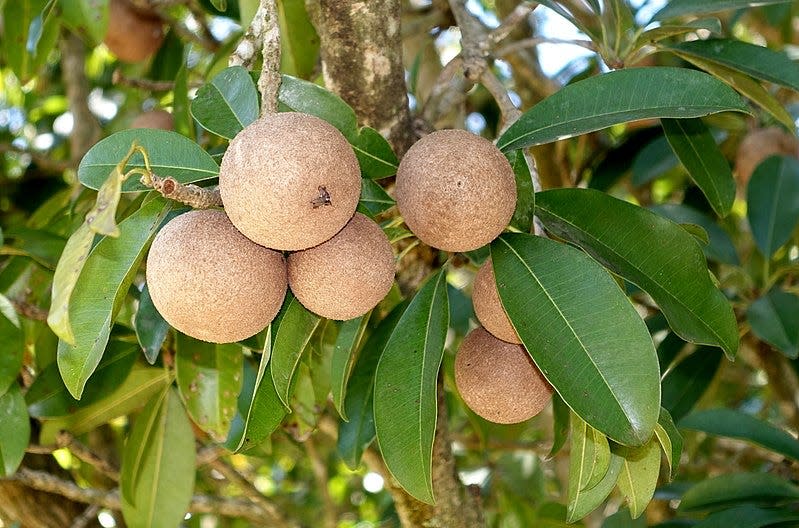Sapodillas are beautiful, low maintenance with tasty fruit. They just can't handle cold

I don’t know when the sapodilla tree at the café in Fairchild Tropical Botanic Garden was planted. But since the 1970s, I’ve enjoyed numerous lunches under its dense, spreading canopy.
Even when it’s not fruiting, that tree (Manilkara zapota) attracts a crowd with its beautiful foliage and an attention-getting sign explaining its significance. You see, the sap of this Mexican and Central American plant was the original source for chicle used to make chewing gum – a process discovered by the Mayan Empire.
Sapodilla tree’s small, bell-shaped, white blossoms appear in spring and summer, followed throughout the warm season by two- to four-inch brown, oval fruit. The fruit, which contain large, black seeds, are delicious, with a somewhat gritty, pear-like texture.
A low-maintenance plant that slowly grows up to 40 feet tall in South Florida, the sapodilla thrives in sun on average soil and, once established, requires little care.
The sole obstacle to its successful cultivation in Central Florida is cold sensitivity: Even mature trees are damaged by temperatures in the upper 20s, so sheltered sites are clearly necessary. Sapodilla can be propagated by seed, but it takes nearly a decade for seedlings to bear fruit. Grafted varieties, however, are widely offered online and mature rapidly.
Clippings: Plenty of bamboo species thrive in Florida, just pick a clumper, not a runner
More: Morgan's Beauty Crassula is well named
All about roses: Rose family includes 5,000 distinct species
Time for winter annuals
Some gardeners love annuals, while others don’t see the point of installing such short-lived plants.
If you’re part of the former group, this is a great time of year. Included among your options are phlox, calendula, petunia, delphinium, snapdragon and pansy. Some perennials treated as annuals in Florida are geranium, dusty miller, alyssum, dianthus, Shasta daisy and statice (Limonium).
A cool-season star
Shooting star is a high-ranking, cool-season perennial for our region. Also called amethyst star because of its clusters of lavender or pinkish star-shaped flowers, this species (Pseuderanthemum laxiflorum) grows two to four feet tall in sun or light shade.
The hardiest of 60 or so Pseuderanthemum species – which are spread out across the tropics – shooting star is a tough-as-nails plant that bounces back from drought and hard freezes to flower the following autumn. In fact, when provided with rich soil, mulched sites and occasional irrigation, shooting star often blooms intermittently much of the year. A related species, P. carruthersii, is known as false eranthemum. It boasts mottled foliage and white-and-purple flowers. Propagate with warm-season cuttings.
Planting palms in winter
Barring a catastrophic freeze, numerous palm species can be installed without concern during the cool season. Fan-leaved palms include Chinese fan, taraw, European fan, needle, lady, ribbon and saw, dwarf and scrub palmettos. Among feather-leaved (pinnate) species are pindo, hardy bamboo, dwarf sugar, seashore, radicalis, caranday and macaw palm. Most prefer sunny sites, but hardy bamboo, radicalis, needle and dwarf palmetto palms need some shade. All the species mentioned, in fact, tolerate light shade, though seashore palm revels in full sunlight.
This article originally appeared on The Ledger: Sapodillas, or chewing gum trees, are great in Florida, except in cold

 money
money 